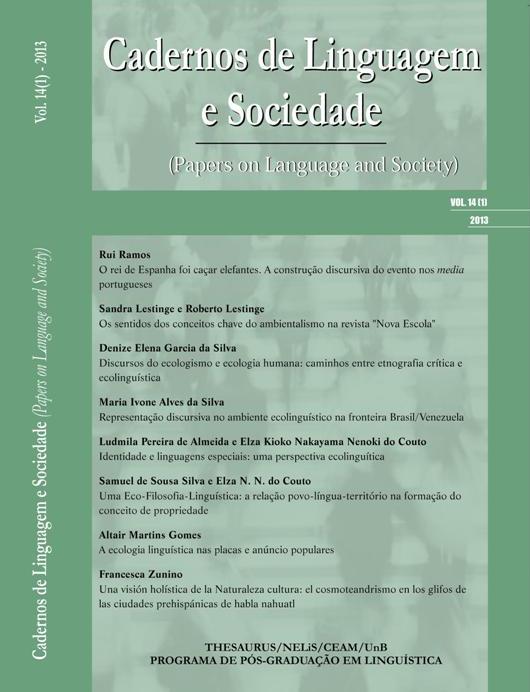ANÁLISE ETNOSSEMÂNTICA DE NOMES COMUNS DE ABELHAS E VESPAS (INSECTA, HYMENOPTERA) NA TERRA INDÍGENA PANKARARÉ, BAHIA, BRASIL
DOI:
https://doi.org/10.26512/les.v14i1.22248Palavras-chave:
Etnoentomologia. Etnotaxonomia. Conhecimento tradicional. Semântica.Resumo
Este artigo focaliza a etnotaxonomia e importância de abelhas e vespas para os índios Pankararé, grupo residente em uma região semiárida do Nordestedo Estado da Bahia, Brasil. Os dados foram obtidos mediante entrevistas semiestruturadas com 14 indivíduos (nove homens e cinco mulheres) da aldeia Brejo do Burgo. Um total de 23 etnoespécies foi registrado e “abeia” é o rótulo usado para apídeos e vespídeos. As “abeias” são classificadas em “abeias-brabas” e “abeias-mansas” e em três taxa intermediários dependendo da posse do ferrão e se conseguem ferroar repetidamente. Esses insetos desempenham significativos papéis na vida social, econômica e cultural desse grupo indígena.Downloads
Referências
ATRAN, S. Folk biology and the anthropology of science: cognitive universals and cultural particulars. Behavioral and Brain Sciences, 21(4): 547-569, 1998.
ATRAN, S. Cognitive foundations of natural history. Londres: Cambridge University Press, 1990.
BANDEIRA, F. P. S. F. Etnobiologia Pankararé. Monografia. Salvador: Universidade Federal da Bahia, 1993.
BERLIN, B. Ethnobiological classification: principles of categorization of plants and animals in traditional societies. New Jersey: Princeton University Press, 1992.
BRASIL, Ministério das Minas e Energia. Projeto “RADAMBRASIL”. Aracaju/Recife: geologia, geomorfologia, pedologia, vegetação e uso potencial da terra, Brasília: Ministério das Minas e Energia, 1983.
BROWN, C. H. Folk zoological life-forms: their universality and growth. American Anthropologist, 81(4): 791-812, 1979.
BROWN, C. H. Language and living things: uniformities in folk classification and naming. New Brunswick: Rutgers University Press, 1984.
BROWN, C. H. Mode of subsistence and folk biological taxonomy. Current Anthropology, 26: 43-64, 1985.
BUZZI, Z. J. Coletânea de nomes populares de insetos do Brasil. Curitiba: Universidade Federal do Paraná, 1994.
Centro de Estatística e Informações. nformações básicas dos municípios baianos. Região Nordeste. Salvador: Governo do Estado da Bahia, 1994.
COUTO, H. H. Ecolingüística: estudo das relações entre língua e meio ambiente. Brasília: Thesaurus, 2007.
Ellen, R. F. The cultural relations of classification: an analysis of Nuaulu animal categories from central Seram. Cambridge: Cambridge University Press, 1993.
HAYS, T. E. Ndumba folk biology and general principles of ethnobotanical classifications and nomenclature. American Anthropologist, 85: 592-611, 1983.
HUNN, E. The utilitarian factor in folk biological classification. American Anthropologist, 84: 830-847, 1982.
HUNN, E. Tzeltal folk zoology: the classification of discontinuities in nature. Berkeley: University of California, 1997.
LENKO, K.; PAPAVERO, N. Insetos no folclore. São Paulo: Cons. Est. Art. Cienc. Hum, 1979.
MACHADO, I. C. S. Biologia floral de espécies de caatinga no município de Alagoinha (PE). Tese de Doutorado, USP, 1990.
MAFFI, L. Language and the environment. In: POSEY, D. A. (org.). Cultural and spiritual values of biodiversity, p. 22-29. Londres: ITP, 1999.
MAIA, S. M. Os Pankararé do Brejo do Burgo: campesinato e etnicidade. Monografia. Salvados: Universidade Federal da Bahia, 1992.
NOLAN, J. M.; ROBBINS, M. C. E. Emotional meaning and the cognitive organization of ethnozoological domains. Journal of Linguistic Anthropology, 11(2): 240-249, 2001.
NOLAN, J. M.; JONES, K. E.; MCDOUGAL, K. W.; MCFARLIN, M. J.; WARD, M. K. The lovable, the loathsome, and the liminal: emotionality in ethnozoological cognition. Journal of Ethnobiology, 26(1): 126-138, 2006.
PINTO, E. As máscaras-de-dansa dos Pancararu de Tacaratu (remanescentes indígenas dos sertões de Pernambuco). Nordeste Indígena, sér. Etnohistória, 2: 5-15, 1991.
POSEY, D. A. Topics and issues in ethnoentomology with some suggestions for the development of hypothesis-generation and testing in ethnobiology. Journal of Ethnobiology, 6(1): 99-120, 1986.
REVEL, N. Fleurs de paroles: histoire naturelle Palawan I: lens dons de Nägsalad. Paris: Editions Peeters, 1994.
ROUBIK, D. W. Ecology and natural history of tropical bees. Cambridge: Cambridge University Press, 1989.
SANTOS-FITA, D.; Costa Neto, E. M. Sistemas de clasificación etnozoológicos. In: COSTA NETO, E. M.; SANTOS-FITA, D.; VARGASCLAVIJO, M. (orgs.). Manual de Etnozoología: una guía teórico-práctica para investigar la interconexión del ser humano con los animales, p. 67-94. Valencia: Tundra Ediciones, 2009.
STURTEVANT, W. C. Studies in ethnoscience. American Anthropologist, 66(30): 99-131, 1964.
VIERTLER, R. Métodos antropológicos como ferramenta para estudos em etnobiologia e etnoecologia. In: AMOROZO, M. C. M.; MING, L. C.; SILVA, S. M. P. (org.). Métodos de coleta e análise de dados em etnobiologia,
etnoecologia e disciplinas correlatas, , pp. 11-29. Rio Claro: UNESP/CNPq, 2002.
Downloads
Publicado
Como Citar
Edição
Seção
Licença
Autores/as que publicam nesta revista concordam com os seguintes termos:
Autores/as mantêm os direitos autorais e concedem à revista o direito de primeira publicação, sendo o trabalho simultaneamente licenciado sob a https://creativecommons.org/licenses/by-nc-nd/4.0/o que permite o compartilhamento do trabalho com reconhecimento da autoria do trabalho e publicação inicial nesta revista.



